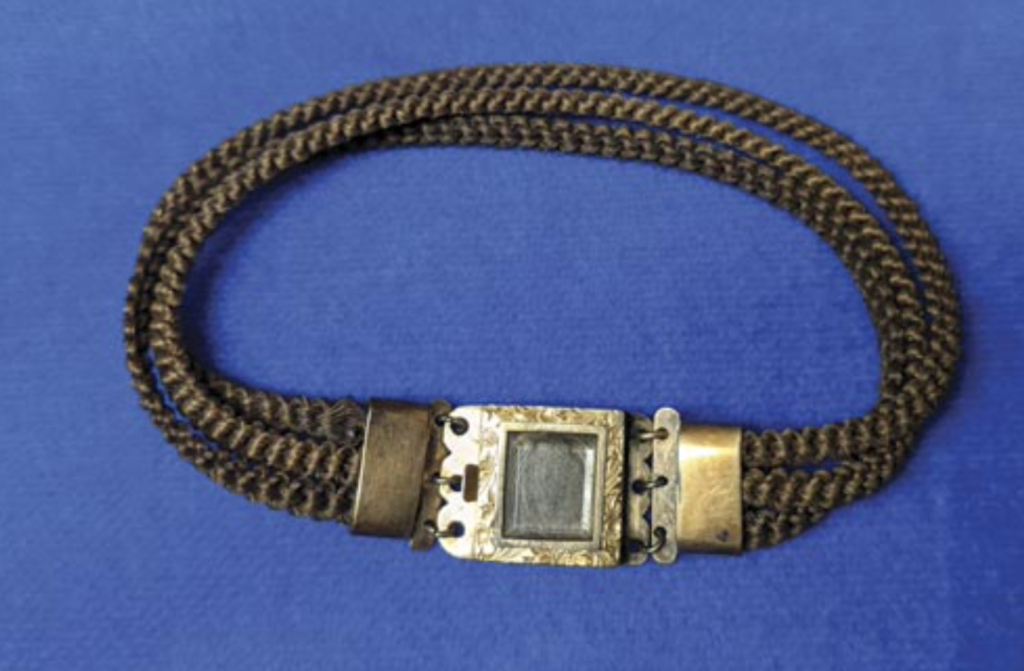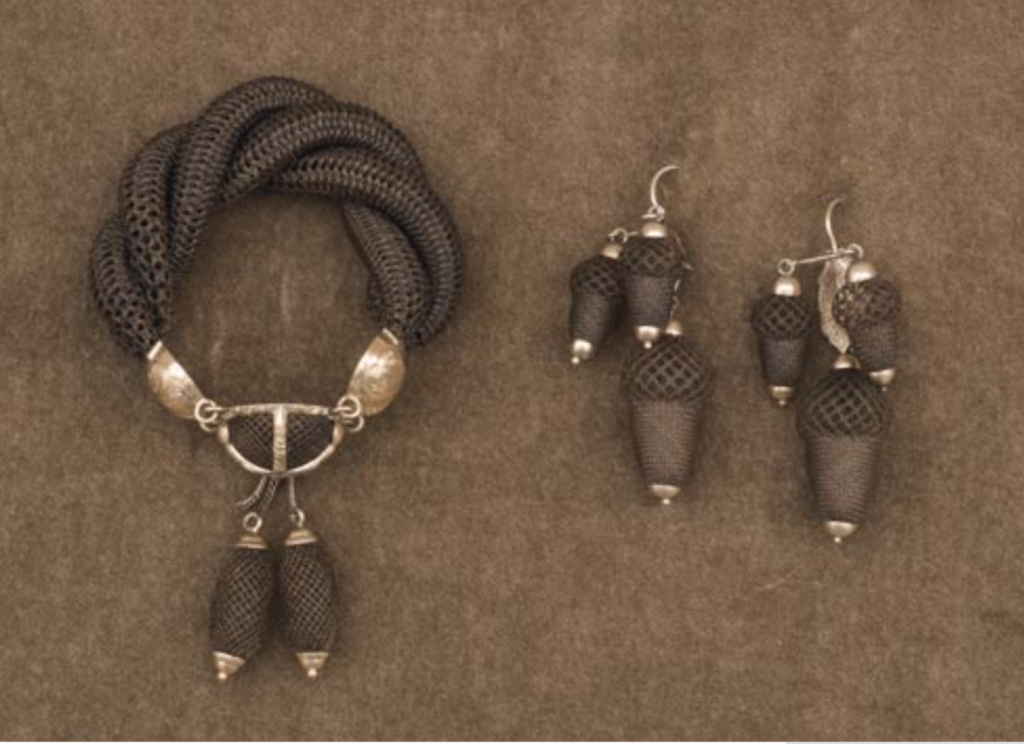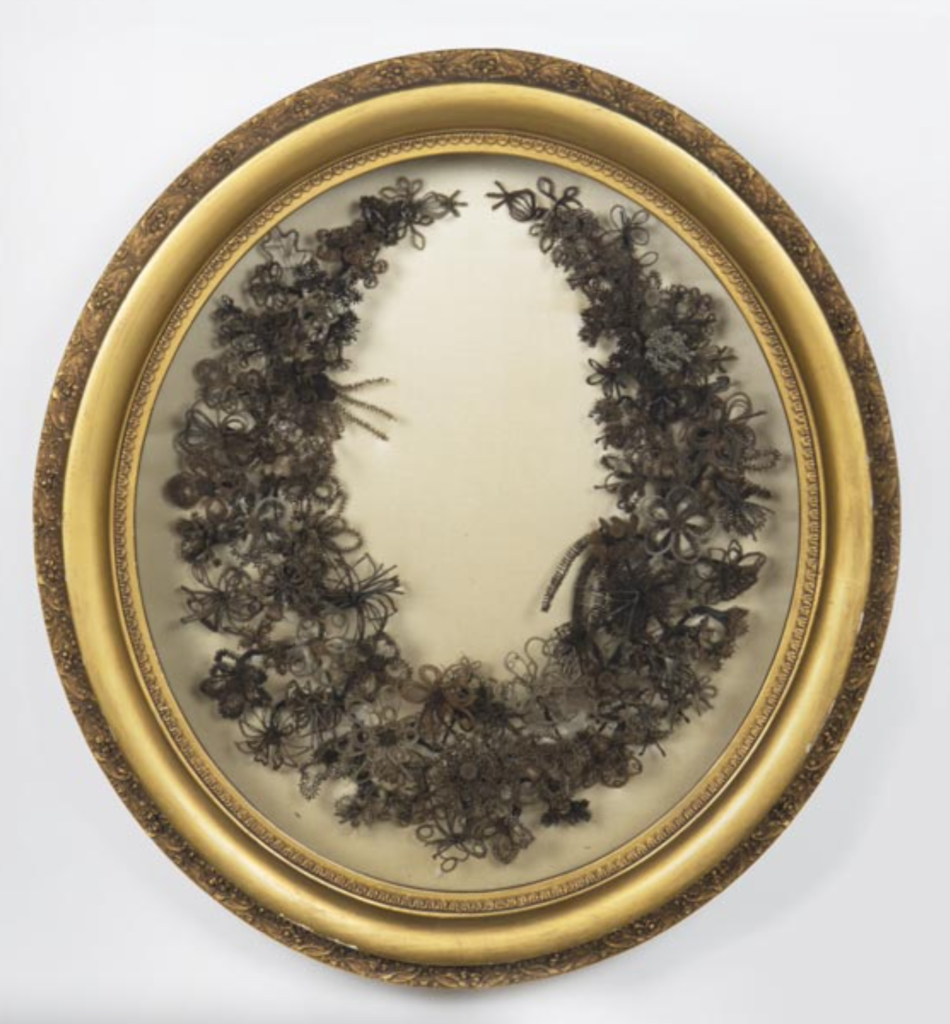
Hairwork brooch of two individuals’ hair (center) surrounded by a tube of woven hair set in leaf-shaped gold mountings. Collection of the Palmer-Warner House, Connecticut Landmarks
By Helen Sheumaker
(c) Connecticut Explored Inc. Fall 2021
Subscribe/Buy the Issue!
Decorative objects made of human hair. Elaborate hair-flower wreaths in heavy wood-cased frames; albums of hair looped and braided and sewn onto the bound pages; finely-worked jewelry including necklaces, brooches, earrings, rings, and bracelets; and watch chains and fobs are just some of the more common forms of hairwork. They were made of human hair because hair was indeed everlasting, resistant to decay and wear. These objects may strike us today as creepy, odd, or just overwrought curiosities from the Victorian era, but Connecticut museums and historical societies have many examples in their collections and it’s worth considering why they were made.
Popular in the United States from the 1770s until the early years of the 20th century, human hairwork had its heyday in the 1850s to 1880s. As I document in Love Entwined: The Curious History of Hairwork in America (University of Pennsylvania Press, 2007), hairwork became an important ritual object for a Victorian white middle class that placed high value on sentimentality. Hairwork was seen as an outward expression of the inner emotion of grief. To both the owner and the observer it served as a constant reminder of the loved one and a marker of the experience of grieving. Even decades after photographic images were readily available to consumers, hairwork remained a popular expression of grief and remembrance.

Hair bracelet presented to Isabella Beecher Hooker as a wedding gift by her family, 1841. Gift of Katharine S. Day, Harriet Beecher Stowe Center. Isabella’s three sisters’ hair (that of Catharine Beecher, Mary Beecher Perkins, and Harriet Beecher Stowe) was plaited and attached to a clasp enclosing their father Lyman Beecher’s hair.
Hairwork was always handmade, usually by independent artisans or “hairworkers.” American-born and immigrant, male and female, young adult and elderly people made hairwork to order, sometimes operating out of their own shops, sometimes filling orders from a jeweler. Many hairworkers were trained in Europe, while others, such as the few African Americans who created hairwork for white customers, were trained in the United States.
The jewelry set by Christian Linherr shown here, in the collection of the Wadsworth Atheneum, is a typical example. Linherr and his brother John A. Linherr, were Swiss immigrants living in New York City. In addition to such standard forms of hairwork, they were capable of sheer flights of artistic fancy. They even exhibited a complete tea set made of hair at the 1853 New York Crystal Palace Exhibition.

Hair bracelet and pair of earrings, c. 1848, made by Christian Linherr, New York. Wadsworth Atheneum Museum of Art
In 1853 William Baldwin, a 22-year-old farmer in New Milford, married Betsy Potter. The 1870 census records William, now 39 years old, as a “Hair Artist.” He remained a “Manufacturer of Hair Jewelry” until at least 1880, according to U.S. Census. Baldwin’s shift in occupation came at the height of the popularity of hairwork, and he likely found it sufficient to support his family.
By the early 20th century, though, changes in clothing styles, interior decor, and a new skepticism of sentimentality spelled a decline in the popularity of hairwork. Today, the jewelry, albums, and wreaths made of hair tell us of the enduring power of emotions and sentiment for those who lived in the American past.

Wreath made of hair by Martha Jewitt Coe, Middlefield, 1859. Connecticut Historical Society, Hartford
Helen Sheumaker, Ph.D. is Associate Teaching Professor, History and Global and Intercultural Studies, Department of History, at Miami University in Ohio. She is the author of Love Entwined: The Curious History of Hairwork in America (University of Pennsylvania Press, 2007).
LISTEN!
Grating the Nutmeg Episode 125: Precious Memories in Hair, an interview with Dr. Helen Scheumaker
21 minutes, released September 1, 2021
GO TO NEXT STORY
SUBSCRIBE/BUY THE ISSUE!
